Abstract
BACKGROUND AND PURPOSE: Many cases of subarachnoid hemorrhage are due to rupture of small cerebral aneurysms. Our purpose was to evaluate the usefulness of helical CT angiography (CTA) in the detection and characterization of very small (<5 mm) intracranial aneurysms.
METHODS: One hundred eighty consecutive patients underwent CTA for suspected intracranial aneurysms. All aneurysms prospectively detected by CTA were confirmed by digital subtraction angiography (DSA) or at surgery. CT angiograms and digital subtraction angiograms were reviewed by two independent blinded radiologists who performed aneurysm detection, quantitation, and characterization using 2D multiplanar reformatted and 3D volume-rendering techniques.
RESULTS: Fifty-one patients harboring 41 very small intracranial aneurysms were included in this series. Eighty-one percent (33 of 41 aneurysms) were ≤4 mm in maximal diameter, and 37% (15 of 41 aneurysms) were ≤3 mm in maximal diameter. Sensitivity of CTA for very small intracranial aneurysm detection ranged from 98% to 100% (95% confidence intervals, 0.871, 0.999, 0.914, and 1.0), compared with 95% for DSA. The specificity of CTA and DSA for very small intracranial aneurysms was 100% (26 of 26 aneurysms). Positive predictive value ranged from 98% to 100%. Negative predictive value ranged from 96% to 100%. Accuracy of CTA for detection of very small intracranial aneurysms was 99% and 100% (κ = 0.969 − 1.0 ± 0.1221). Forty-eight percent of aneurysms were detected in the presence of subarachnoid hemorrhage.
CONCLUSION: The sensitivity of CTA for the detection of cerebral aneurysms ≤5 mm is higher than that of DSA, with equal specificity and high interoperator reliability. High quality, noninvasive CTA aneurysm detection and characterization can be performed using routine clinical CT scanners and commercially available image processing workstations.
- Copyright © American Society of Neuroradiology












